Ruby chocolate, in the form of RB1, has hit the industry, bringing its wonderful creamy berry sourness with it. Kirsten Tibballs shows us how best to use this new type of chocolate in the patisserie.
In September last year, ruby chocolate burst across the culinary world as the latest innovation in chocolate. Last time we saw something this exciting was 80 years ago, when white chocolate was heralded in as the third type of chocolate, joining the ranks of dark and milk chocolate. Ruby now sits among those giants as the fourth type of chocolate, and it has just been released to industry in the form of Ruby RB1.
Ruby chocolate derives its flavour and colour naturally from the ruby bean.
“The natural berry flavour surprised me,” says Kirsten Tibballs, who was one of the first to try ruby chocolate in Australia.
Kirsten received a sample in September 2017, one of the perks of being a Callebaut Ambassador.
“I am the only Callebaut ambassador in Australia and have been for over 18 years. Only the most respected pastry chefs and chocolatiers from around the world are asked, so I am truly honoured,” she says.
“This first form of ruby chocolate by Callebaut is called RB1. Eventually, there will be other versions of ruby and different recipes like there is for white, milk and dark.”
Kirsten says the difference between single origin chocolate and ruby chocolate is that ruby chocolate is made from a particular type of cocoa bean—the ruby bean—as opposed to single origin chocolate, which is made from cocoa beans selected from one particular country.
“So far, ruby beans have only been found in Ivory Coast, Brazil and Ecuador,” she explains.
The ruby bean’s red internal colour is its defining trait, and Kirsten describes its flavour as beautiful berry with slight sour notes.
While the texture is similar to the other types of chocolate, ruby, according to Kirsten, is like nothing else in the world.
“Having first tasted the product, I brainstormed a list of flavours that I felt would match it best. Surprisingly, it pairs well with a lot of different flavours such as green tea, pepper, coconut, star anise and cinnamon. The list keeps going!”
Kirsten recommends chefs experimenting with ruby begin with garnishes and individual chocolate applications.
“This will allow you to get a feel for the chocolate before starting to develop your own concepts and products. Also, with ruby chocolate, it is important to store it in opaque packaging and keep it well sealed at all times to avoid it absorbing moisture from the atmosphere.”
Kirsten, who has used the chocolate in everything from individual chocolates and chocolate bars to tarts, caramels and panned products, says that combining ruby with other ingredients dilutes the fruity flavour and colour.
“Callebaut has made a conscious effort to reduce the sugar content, so it is less sweet than white chocolate.”
She also recommends tempering ruby at a slightly lower temperature than other chocolates, and to aim for between 28.5°C and 29.5°C.
Kirsten says it’s important for chefs and chocolatiers to introduce new products to their offerings.
“Chefs must develop their products seasonally. This enables their customers to see and try new products. It also encourages creativity and innovation as they are constantly implementing new ideas.
“Ruby is the first new chocolate in over 80 years, so it is really exciting to have something that will inspire creativity for new products.”
Ruby Tart
WHAT YOU NEED
Peanut Shortbread
310g unsalted butter, softened
190g icing sugar
65g ground peanuts
5g salt
2 Heilala vanilla beans
100g whole eggs
500g plain flour
Peanut and Ruby Crunch
250 g Callebaut Ruby RB1 chocolate
80 g roasted salted peanuts, chopped
80 g peanut butter
Raspberry and Peanut Butter Cream (PB & J)
500ml Bulla Pure cream 45% fat
200g caster sugar
100ml water
130g Callebaut Ruby RB1 chocolate
3g Maldon sea salt
40g unsalted butter, diced
150g fresh or frozen raspberries
250g crunchy peanut butter
2 Heilala vanilla beans, cut and scraped
Ruby Whipped Ganache
250g Bulla Thickened cream 35% fat
25g liquid glucose
QS pink colour
150g Callebaut Ruby RB1 chocolate
325ml Bulla Pure cream 45% fat
WHAT TO DO
Peanut Shortbread
1. In the bowl of a stand mixer fitted with paddle attachment, mix the soft butter with the icing sugar and ground peanuts.
2. Add the salt, vanilla and eggs and continue mixing.
3. Add the flour and mix until just combined.
4. Remove from the mixer and press it into a flat square. Cover with plastic wrap and keep in the fridge to chill.
5. Roll the dough out to 3mm thickness and line the 18cm tart ring with the pastry.
6. Line the tart with baking paper or plastic wrap and fill it with baking beads or uncooked rice.
7. Bake at 170°C for 10-12 minutes.
8. Remove the lining and continue to cook for 4-6 minutes.
Peanut and Ruby Crunch
1. Melt the ruby chocolate in a plastic bowl in the microwave for 30 seconds at a time until it is half melted. Stir vigorously until fully melted.
2. Add in the peanut butter and chopped peanuts and combine.
3. Spread a thin layer into the base and sides of the tart.
Raspberry and Peanut Butter Cream
1. Semi-whip the cream in the bowl of a stand mixer fitted with a whisk attachment until it has some body but still collapses. Store in the fridge until needed.
2. In a saucepan, bring the sugar, water and cut and scraped vanilla beans to the boil.
3. Place the peanut butter and ruby chocolate in a bowl. Pour the boiling mixture over the chocolate and peanut butter and whisk to combine.
4. Add in the salt and the butter a piece a time while whisking. Ensure each piece of butter has combined before adding the next.
5. Cool to approximately 35°C (95°F) (just below body temperature to touch) before folding in the semi-whipped cream with a spatula.
6. Place in the fridge for 1 hour to firm up.
7. Fold the raspberries in prior to piping. Once it firms up, pipe the cream into the centre of the tart shell.
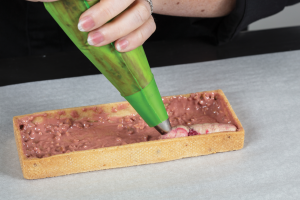
Ruby Whipped Ganache
1. Boil the cream and glucose in a saucepan.
2. Pour the hot mixture over the Ruby chocolate in a bowl and whisk until melted.
3. Add in the chilled cream and place in the fridge for a minimum of 4 hours.
4. Whip the cream just prior to serving your tarts.
5. When ready to use, pipe the cream onto the raspberry and peanut cream centre.
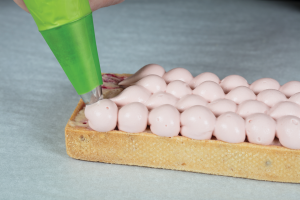
Ruby Tiger Print Chocolates
WHAT YOU NEED
Mould Preparation
Half sphere 30mm polycarbonate chocolate mould (ref CW2022)
80g Callebaut 811 dark couverture 54%
edible pink metallic powder
Moulding
300g Callebaut Ruby RB1 chocolate
Strawberry Confit
180 g Ravifruit strawberry puree
3 g mint leaves
120 g strawberries,
diced into approximately
5mm cubes
15 g citrus pectin
60 g caster sugar
6 ml lemon juice
Ruby Chocolate Ganache
240ml Bulla thickened cream 35% fat
130g Bulla crème fraiche
3 Heilala vanilla beans, split and scraped
380g Callebaut Ruby RB1 chocolate
2g+ Maldon sea salt
60g unsalted butter, softened and at room temperature
Beetroot powder or red oil soluble colour (optional)
60g liquid glucose
Sealing the mould
100g Callebaut Ruby RB1 chocolate
WHAT TO DO
Mould Preparation
- Prepare the mould by polishing it with cotton wool.
- Melt the chocolate or temper it if it contains cocoa butter. To temper the chocolate, heat it in a plastic bowl in the microwave for 30 seconds at a time until you have 50% liquid and 50% pieces of chocolate. Stir it vigorously without additional heat until all the chocolate has melted. If you have some resistant chocolate, you can gently heat with a hair dryer while stirring.
- Prepare a paper piping cone and fill it approximately halfway with the prepared chocolate and cut a small amount off the tip.
- Pipe lines of chocolate directly into the mould in a tiger print design, starting wide on one edge and becoming narrower.
- Scrape the top of the mould regularly to remove any chocolate from the surface then continue piping.
- Allow to set.
- Dust the mould with pink metallic powder.
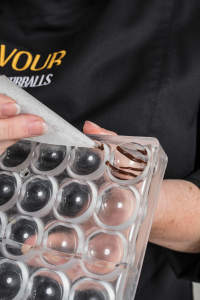
Moulding
- Temper the chocolate (see the instructions above). The chocolate must be between 29°C and 31°C.
- Wearing a glove, use your finger to rub some of the chocolate into each cavity of the mould. This allows the cocoa butter to melt slightly so it contracts with the chocolate that’s piped in next and becomes one piece.
- Fill a piping bag with the chocolate and pipe into each cavity of the prepared mould.
- Tap the mould on the bench to dislodge any air bubbles. Turn the mould upside down over a sheet of baking paper and tap with the handle of the scraper to remove the excess chocolate. Once all the excess chocolate has been tapped out, scrape the mould while it is still upside down. Ensure the top surface of the mould is scraped clean.
- Place the mould on its side to set at room temperature.
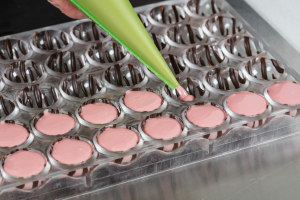
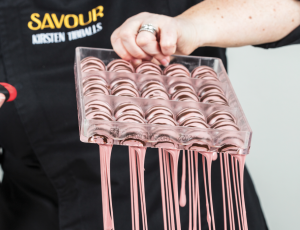
Strawberry Confit:
- Combine the strawberry puree and mint leaves and bring to a boil.
- Strain the puree into a clean saucepan, add the diced strawberries and bring the mixture back to a boil.
- Combine the pectin and sugar together in a bowl, and gradually add this to the boiling fruit mixture.
- Maintain a boil for 2 minutes.
- Remove from the heat and add the lemon juice.
- Cool the mixture to 30°C before piping into the prepared chocolate moulds.
Ruby Chocolate Ganache
- Combine the cream, crème fraiche, vanilla beans, warmed glucose and salt in a small saucepan and bring to the boil.
- Emulsify the cream mixture with a stick blender and ensure that the salt is completely dissolved. Taste it to check if more salt is required.
- Emulsifying with a stick blender, add in the butter, a piece at a time, ensuring that each piece is completely dissolved before adding the next.
- Cool the cream mixture to 30°C.
- In the meantime, melt the chocolate to 40°C.
- Combine the melted chocolate and cooled cream mixture with a stick blender.
- Cool to 30°C before piping into the prepared moulds on top of the confit.
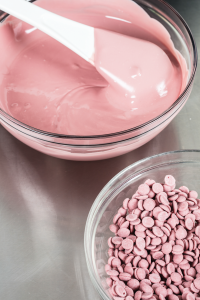
Sealing the mould
1. Melt the chocolate or temper it if it contains cocoa butter. To temper the chocolate, heat it in a plastic bowl in the microwave for 30 seconds at a time until you have 50% liquid and 50% pieces of chocolate. Stir it vigorously without additional heat until all the chocolate has melted. If you have some resistant chocolate, you can gently heat with a hair dryer while stirring.
2. Place the tempered chocolate into a disposable piping bag and pipe a thin layer on top of the ganache filling.
3. Move the mould from side to side on the bench to level out the chocolate.
4. Place a sheet of plastic on top of the mould and scrape the top surface
5. Press a metal scraper firmly on the surface of the mould and scrape off all the excess chocolate. Clean the sides of the mould by scraping off the excess chocolate and allow to set at room temperature.
6. Once the chocolate has set, place the mould in the fridge for 20 minutes.
7. Remove from the fridge and leave at room temperature for 10 to 15 minutes before unmoulding.
8. To unmould the chocolates, place a board on top of the mould and creak it like an ice cube tray before turning it over. Tap out any chocolates that are stuck.

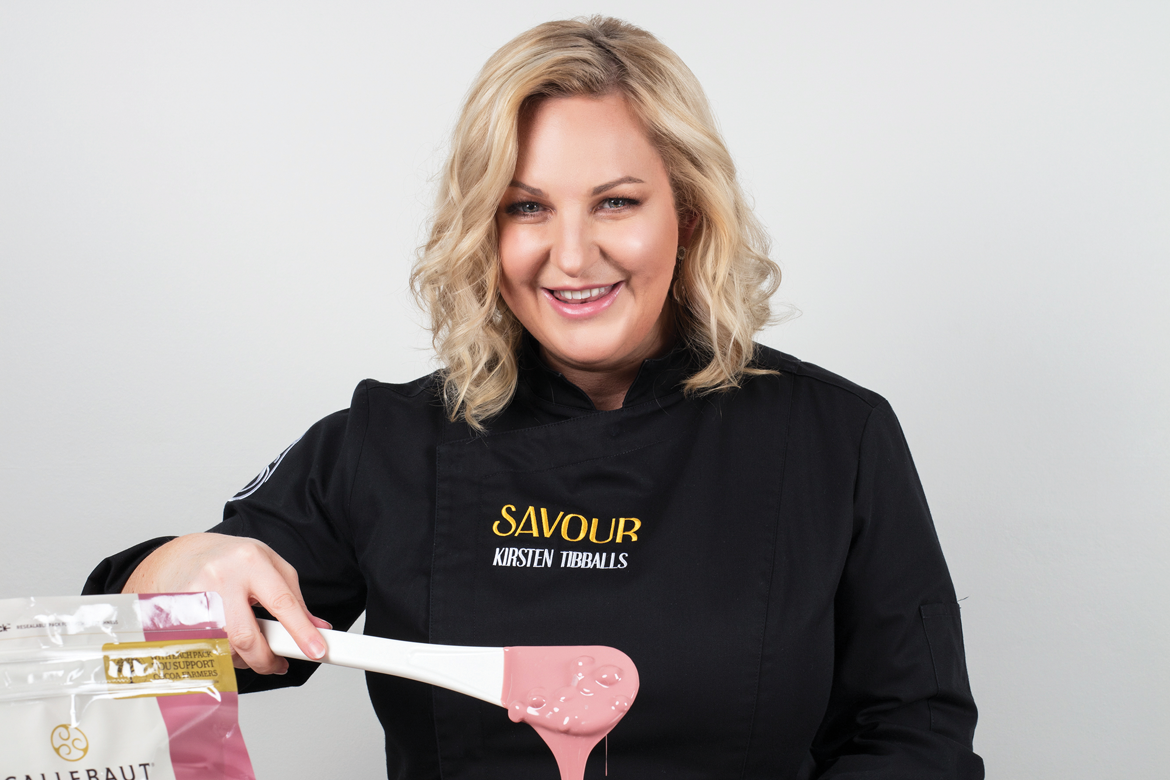



COMMENTS